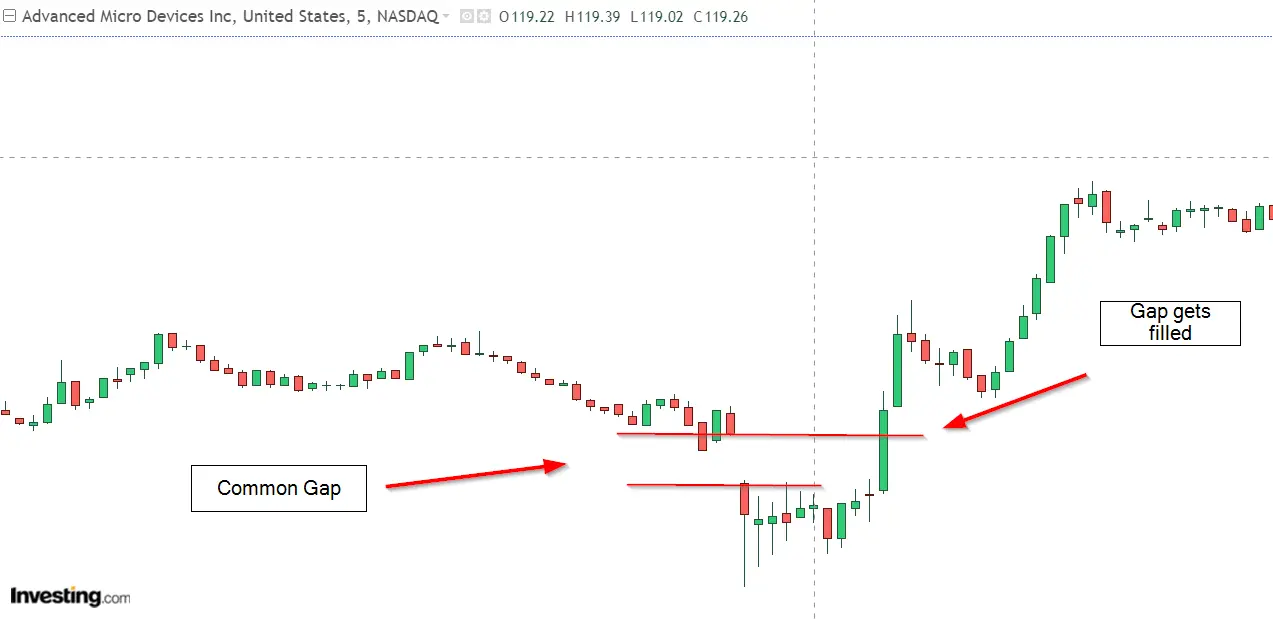Common stock gaps are an important stock price behavior to understand as they can carry different implications. As a day trader, it’s important to make sense of common gaps in order to get a better understanding of normal price behavior.
Summary
- Common gaps occur due to regular market conditions and can happen in trending and non-trending markets
- They are identified by a “gap” in price between the closing of one bar and the opening of the next
- Common gaps occur most regularly between the closing of one trading session and the opening of another
What is the Common Gap?
The common gap is an occasional price gap that occurs in trading for a particular trading instrument. They happen due to regular trading activity and normal market behavior. Common gaps don’t follow any type of price pattern and are as the name implies, common.
Understanding Common Gaps in Trading
The common gap doesn’t occur due to major news events. It’s simply a by-product of normal market behavior and is non-linear. In general, it appears out of nowhere for no direct reason and can occur in both trending and non-trending price patterns.
The size of the gap usually tends to be pretty insignificant in size and gets filled 90% of the time. Since gaps occur pretty regularly, they usually fail to provide any significant insight into how a stock will perform for the day. They are used by market technicians as a reference point into the potential daily trading range of a trading instrument, most commonly stocks.
Properties of Common Gaps
- Common gaps occur most frequently between the close of one trading session and the opening of another (stock market opening up at 9:30 EST and closing at 4:00)
- A common gap tends to have low trading volume on the day it gaps
- There is a “gap” in price between the closing of one bar and the opening price of the next
Why Do Common Gaps Occur?
While most people operate under the notion that common gaps are random, there is a reason as to why they occur. After-market-hours trading and pre-market-hours trading can impact on how a stock opens up.
If there are random retail or institutional orders being opened or closed during after-market-hours trading, it can impact the opening price the following day. The size of the gap depends on the amount of buying and selling which happens during aftermarket hours trading.
Another reason common gaps occur is due to options contract assignment. An option assignment occurs when an options contract gets exercised and a trader gets assigned shares as a result of the exercise. When this happens, shares of stock are purchased or sold based on the amount of options contracts the trader was holding. Assignment of shares happens after the market has closed.
Making Sense of Common Gaps
Now that you know how common gaps work and why they happen, how should you interpret them? It’s important to consider what kind of securities are having gaps.
- Lower trading volume: You will notice gaps more frequently on securities that naturally have low trading volumes. In thinly traded securities, gaps don’t offer much insight into the future behavior of price action. They do however matter more in securities where trading volume is higher.
- Time frame: It’s important to consider the time frame in which you are viewing your charts. If you are viewing charts on the 5-minute time frame, you will notice more gaps. If you are viewing it on a daily chart time frame, chances are that gaps won’t even show up.
- How quickly the gap is filled or not filled: This is an important factor to consider. If a gap gets filled quickly, it means that the price was never really in the direction of the gap. Buyers or sellers quickly pushed the stock in the direction of their trend.
Common Gap Example
Below is an example of what a common gap looks like. As you can see AMD stock gapped down on open (5-minute chart) and then roughly an hour later the gap ends up getting filled. The example below is an indication that the price of AMD is bullish despite the temporary gap down in price at open.
Important Note: As previously mentioned, you have to pay close attention to the time frame you are observing for gaps. A gap that appears on the 5 minute time frame may not appear on the daily.

How to Read Common Gaps to Make Profitable Trades
If you want to become a profitable trader, it’s important to be able to identify the type of price gap that has occurred and be able to distinguish between them. Each type of gap has a different implication. Some of the other types of gaps include:
The first step is to focus on finding common gaps. Take the following steps below.
1.) Filter stocks that have a gap up or gap down in price for a maximum of 2%. This can be done with Finviz.com
2.) Identify the direction of the gap
3.) Measure the volume of the current day vs the average volume
4.) Wait and see in which direction the stocks start to move 30 minutes to 1 hour after open
5.) If you begin to see that there is a strong reversal from the original direction of the gap, take the trade.